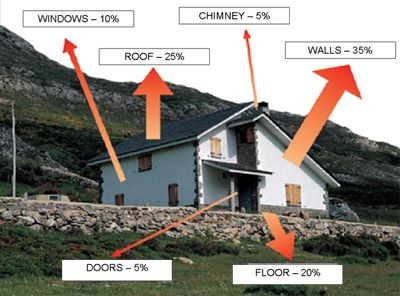COOL-Coverings: a range of nanotech coatings to improve Near Infrared (NIR) reflective properties of buildings
The COOL-Coverings project addressed a range of insulation solutions based on nanotechnology coatings. These coatings aim at improving the Near Infrared (NIR) reflective properties of construction materials, thereby improving the energy efficiency in buildings. A set of new materials was developed to be implemented into several construction components.

The challenge
The main challenge of the COOL-Coverings project consisted in developing coloured materials (even dark) for construction that stay cool under sun radiation. These two features can be combined by increasing the reflectance of standard coloured materials in the Near Infrared (NIR) range where the sun emits more than 50% of its energy.
The innovation
Heat losses in buildings are mainly located in roof and walls (see picture below). To compensate these losses, cooling and heating actions are carried out, thereby leading to large amounts of energy consumption. In order to reduce the lossess, insulation and thermal reflection represent crucial issues.
The COOL-coverings project, co-financed by the FP7 grant funding programme, addressed these issues. Implemented from June 2010 to May 2013, it was coordinated by Keraben (Spain), a company specialized in ceramics.
The key concept of the COOL-Coverings project was to develop multifunctional coatings with selective properties (absorbing in the visible and reflecting in the NIR). To achieve this, a set of nanocrystalline oxide pigments that could be implemented into different types of building components (i.e. outdoor walls, indoor walls and roofs) was studied. Different types of applications were developed:
reflecting paints and reflecting ceramic tiles for outdoor walls,paints and ceramics for indoor walls, andreflecting waterproof membrane systems for the roof.The key is to enhance the NIR reflection properties of the final coated construction material by working at the nanoscale and tuning the particle size and distribution of selected nano-oxides. To achieve such a nano insulation approach, the set of materials that was selected was studied under boundary conditions, taking into account process feasibility, users processability and safety. Several inorganic metal-oxides were selected (i.e. Al2O3, ZnO, TiO2, SnO2, SiO2) and incorporated into construction materials. These materials were tested in middle scale mock-ups: 5 different units (each façade about 3m) were realized and covered with NIR reflecting coatings. Three classes of materials were analysed: black ceramic tiles for façades, green ceramic tiles for façades and grey bituminous membranes for roofs. Results showed a significant improvement of the building insulation envelope.
Why did it work?
COOL-Coverings addressed the entire innovation cycle from research to market introduction. This means:
Research and Development of NIR nano oxides, (ii) production of nano-oxides,integration of new solutions into traditional products and manufacturing processes,modelling and testing of new materials,health risk assessment and safety issues analysis.
Moreover, different types of stakeholders (SMEs, large companies and research entities) were committed in this project, thereby involving the whole value chain, from nano materials manufacturers to building companies.
Further deployment
As the material solutions developed were tested in a relevant environment at the prototype scale, the technology readiness level is estimated to be 6 on the TRL scale. Moreover, thermal simulations were carried out on different test cases (e.g. commercial building, five storey buildings) and a business model developed. The next step could be the deployment of these cool materials at scale 1 on buildings.
Links:
The website